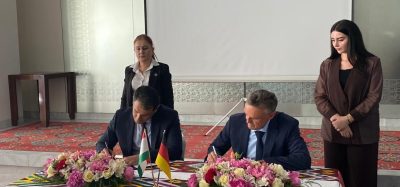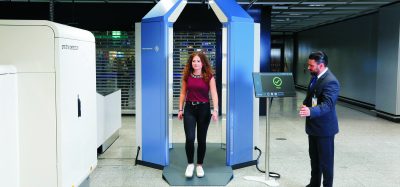Aeroporti di Roma and FS Italiane to develop sustainable intermodality
- Like
- Digg
- Del
- Tumblr
- VKontakte
- Buffer
- Love This
- Odnoklassniki
- Meneame
- Blogger
- Amazon
- Yahoo Mail
- Gmail
- AOL
- Newsvine
- HackerNews
- Evernote
- MySpace
- Mail.ru
- Viadeo
- Line
- Comments
- Yummly
- SMS
- Viber
- Telegram
- Subscribe
- Skype
- Facebook Messenger
- Kakao
- LiveJournal
- Yammer
- Edgar
- Fintel
- Mix
- Instapaper
- Copy Link
Posted: 18 March 2022 | International Airport Review | No comments yet
Aeroporti di Roma and Ferrovie dello Stato Italiane have signed an agreement to develop sustainable intermodality and integration between both the rail and aviation sectors.


Ferrovie dello Stato Italiane (FS Italiane), with CEO Luigi Ferraris, and Aeroporti di Roma (ADR), with CEO Marco Troncone, have signed an agreement to develop sustainable intermodality and integration between rail and air. The presentation of the agreement, at Fiumicino’s Leonardo da Vinci Airport (FCO), was attended by Fiumicino Mayor Esterino Montino, Rome Mayor Roberto Gualtieri, ENAC President Pierluigi Di Palma and Lazio Region, Nicola Zingaretti.
To encourage the transition to the smart hub status of the airports managed by ADR, the agreement aims to enhance direct high-speed connection services between Fiumicino Airport and the South of Italy, to accelerate current services with the North of the country (Florence/Bologna/Pisa). In particular, there is a desire to develop integrated train and air products by implementing commercial agreements with airlines at Fiumicino to integrate the reciprocal sales and distribution systems with the possibility of passenger and baggage check-in directly at the main railway stations connected to Leonardo da Vinci. In other words, you can get on the train in stations such as Florence, Bologna or Naples and get off directly at your destination, even overseas, in a simple, safe, fast, and comfortable way. Not least among the objectives set is the improvement and development of passenger information on flights and train movements in trains, stations, and airport terminals. The station thus becomes a true extension of the airport terminal.
With this in mind, in addition to expanding connections and enhancing the flow of information, the project includes the infrastructural development of Fiumicino Aeroporto station, where it is planned to increase from the current three tracks to a total of five. The development of road transport is also envisaged, with investments and road projects. Further planned improvements and developments of the line concern the construction of the FL1 and FL5 connections via San Pietro and with Civitavecchia and a quadrupling of the Ponte Galeria-Fiumicino Airport section. For the high-speed direct connection, the project foresees the closure of the Rome railway loop and infrastructure bypasses for direct trains to Fiumicino without stopping at Roma Termini.
As part of Urban Air Mobility (UAM), the agreement also includes the design and construction of a vertiport on the car park plate of Rome’s Termini Station and the identification of further suitable spaces for the future expansion of this network. ADR is actively working in this field to launch the first commercial operations between Fiumicino airport and the metropolitan city of Rome in 2024.
TAKE A READ:
The way we see innovation by Giulio Ranucci, Head of Innovation & Digital for Aeroporti di Roma
Aeroporti di Roma to accelerate green transition with Eni biofuel
Simplifying air operations at Fiumicino International Airport by Fabrizio Magliocca, Head of APOC Management at for Aeroporti di Roma
“The agreement with FS Italiane is a strategic one,” commented Troncone. “Not only for ADR but for the country’s integrated mobility sector, fully in line with the policies indicated by our government. Through the launch of a real intermodal train-to-air offer, which enhances Fiumicino’s role as a smart hub, it maps out and anticipates new mobility in the name of sustainability and the multiplication of connectivity opportunities for travellers. And by enhancing accessibility to the airport, it makes Fiumicino more ready for the recovery of tourism and, more generally, for a future of growth, right from the next appointments until the Jubilee 2025.”
Ferraris said: “Rail and air transport must co-operate in a context of integrated and sustainable mobility, through strategic collaborations aimed at creating a convergence of objectives, generating benefits for both sectors and the mobility system in general. The agreement with Aeroporti di Roma goes in this direction. It bears witness to the commitment of the Italian Gruppo FS to facilitate connections between the country’s main gateways such as stations, airports and ports. We are working to build new rail infrastructure, upgrade existing infrastructure, and offer the services. Rapid action is needed to make the whole country more competitive and attractive with a sustainable, multimodal, efficient, and interconnected transport system for both people and goods.”
“Strategic and sustainable intermodality – this is the objective that the country must aim for to be competitive at the international level, starting with Italy’s most important gateway, Fiumicino Airport,” added Di Palma. “To do this, the industry needs to restart as soon as possible, without hesitation. To meet the needs of one of the industry hardest hit by the crisis, ENAC has overcome bureaucratic obstacles and has already advanced the airport management companies to the first tranche of 300 million euros, equal to 50 per cent of the compensation requests made for damages caused by the COVID-19 health emergency. About 110 million have been allocated to Aeroporti di Roma to help it restart. The ADR – FS agreement is essential to enhance the integration between train and air. Still, sustainable intermodality is equally crucial to promote advanced air mobility, which will allow, among other things, air taxi flights between Fiumicino airport and the city centre from 2024. The ENAC, together with the entire social and industrial fabric of our country, is ready for the new integrated mobility: the future has arrived”.
“What we are presenting here is an ambitious project,” mentioned Gualtieri, “Which is part of the wider process of developing increasingly modern and sustainable mobility in Rome. I would therefore like to thank Ferrovie dello Stato Italiane and Aeroporti di Roma for this protocol, which will enable us to consolidate transversal sectors and competencies – from mobility to tourism to services for citizens – in the wake of two major strategic axes: intermodality and accessibility. Fiumicino Airport, an airport of fundamental importance for the whole country, will benefit from new infrastructure, more direct connection services, and greater integration between rail and air. This is a forward-looking strategic choice, which gives us a clear view of the direction that logistics and transport will take in the coming years. As Capitoline Administration, we are committed to promoting interconnection and sustainable mobility in all its forms, exploiting the great potential that comes from the NRP, in the name of innovation and digital industry. This agreement allows us to act in synergy, to seize better opportunities of extraordinary importance such as the Jubilee 2025 and the challenge of Expo 2030”.
Zingaretti further commented: “We make a further leap forward in strengthening rail connections and enhancing Fiumicino Airport, Italy’s most important gateway to the world. We have been working in great harmony with Ferrovie dello Stato Italiane and Aeroporti di Roma on these objectives for nine years now. The project we are launching represents a very important new challenge, crucial in a phase like the one we are living in. Better connecting the country today is crucial for creating new development and new jobs and for increasing people’s well-being. The NRP will greatly boost these objectives, and the Lazio Region will continue, as it has done in recent years, to invest in this priority mission. Fiumicino is a central airport for the whole country. It will be even more so in the next few years, with the major international events that will see Rome and Lazio as protagonists, starting with the jubilee of 2025. With FS and ADR, we are putting down on paper a strategic plan to ensure that we are ready for the major challenges of the coming years”.
Related topics
Advanced air mobility (AAM), Airport development, Airside operations, Baggage handling, COVID-19, Digital transformation, Passenger experience and seamless travel, Sustainability, Sustainable development
Related airports
Aeroporti di Roma (FCO), Rome Fiumicino International Airport (FCO)
Related organisations
Related regions
Related people
Esterino Montino, Luigi Ferraris, Marco Troncone, Nicola Zingaretti, Roberto Gualtieri


















